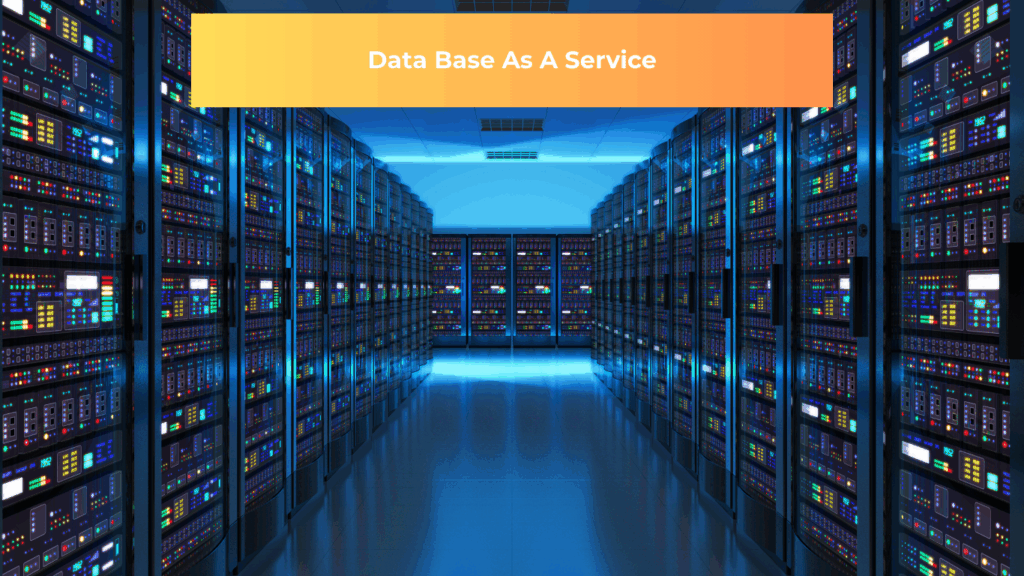Unlock efficiency with Database as a Service (DBaaS). HBLAB’s best DBaaS solutions deliver scalability and innovation globally. Contact us today!
By 2025, the Database as a Service (DBaaS) market is set to soar to USD 320 billion, driven by businesses seeking agile, cost-effective data solutions. As organizations embrace digital transformation, Database as a Service offers a cloud-based model to streamline data management without the complexities of hardware or software setup.
What is Database as a Service (DBaaS)?

Database as a Service (DBaaS) is a cloud computing model that provides fully managed database solutions, eliminating the need for businesses to invest in physical hardware, install software, or manage infrastructure. Providers handle maintenance, upgrades, backups, and security, allowing organizations to focus on leveraging data for strategic goals.
This model supports relational databases (e.g., MySQL, PostgreSQL) and non-relational databases (e.g., MongoDB, DynamoDB), offering flexibility for diverse applications. There is a significant growing number of enterprises that will adopt DBaaS to enhance agility and reduce costs, making it a cornerstone of modern IT strategies in this day and age.
Categories of DBaaS Providers
The Database as a Service ecosystem offers diverse provider types, each with unique strengths and trade-offs:
- Public Cloud Providers: Giants like AWS, Azure, and Google Cloud offer Database as a Service providers such as Amazon RDS and Azure SQL Database. These integrate seamlessly with existing cloud accounts for computing and storage.
- Pros: Simplified billing, diverse database options.
- Cons: Risk of vendor lock-in, challenges with hybrid environments, data egress fees.
- Proprietary Cloud Vendors: Providers like Snowflake and Firebolt offer specialized managed database services hosted on public clouds but managed by the vendor.
- Pros: Streamlined deployment, robust feature sets.
- Cons: Potential lock-in, higher server costs due to vendor markups, cloud-only focus.
- Partner DBaaS Companies: Vendors like Vertica operate in public cloud marketplaces, allowing separate contracts with cloud providers.
- Pros: Multi-cloud support, specialized features, no lock-in, hybrid compatibility.
- Cons: Managing multiple vendor contracts for billing and licensing.
Explore HBLAB’s expertise in multi-cloud scalable DBaaS solutions
How DBaaS Works in Cloud Computing

Database as a Service in cloud computing leverages shared cloud infrastructure (e.g., AWS, Azure, GCP) to host database engines, accessible via APIs for seamless application integration. Providers manage hardware, software, and security, ensuring high availability and cloud database scalability.
The DBaaS framework follows a 4-step process:
- Assessment: Analyze data workloads, compliance needs, and scalability goals.
- Provisioning: Deploy tailored databases like PostgreSQL or MongoDB Atlas.
- Management: Automate backups, updates, and monitoring with managed database services.
- Optimization: Dynamically scale resources for peak performance, such as during e-commerce surges.
This approach minimizes administrative overhead while maximizing efficiency.
DBaaS vs. Traditional Database Management
Database as a Service transforms traditional database management, offering unmatched agility and efficiency. Key differences include:
| Aspect | DBaaS | Traditional Database Management |
| Infrastructure | Cloud-based, provider-managed | On-premises, IT-managed |
| Provisioning | Self-service via APIs/portals | Manual, time-intensive |
| Maintenance | Automated updates and patches | Manual, requiring expertise |
| Performance Tuning | AI-driven optimization | Manual, skill-dependent |
| Cost Structure | Pay-as-you-go, no upfront costs | High capital and maintenance costs |
For example, traditional setups require weeks to provision new databases, while DBaaS enables deployment in minutes.
Benefits of Database as a Service
Database as a Service (DBaaS) is a game-changer for businesses looking to streamline data management and spark innovation. By tapping into the power of the cloud, DBaaS takes the hassle out of managing databases, letting you focus on what matters—growing your business. It’s like having a top-notch IT team handling the heavy lifting, so you can prioritize strategy and results. Here’s why scalable DBaaS solutions are a must-have in 2025:
- Saves You Money: With Database as a Service, you can cut infrastructure costs by up to 40% since there’s no need to buy pricey hardware or maintain it. You pay only for what you use, keeping budgets predictable and avoiding wasteful spending on extra capacity. It’s a smart, wallet-friendly way to manage data.
- Scales Effortlessly: Need to handle a sudden surge in data? Cloud database scalability lets you ramp up or scale down resources in a snap, ensuring smooth performance during busy times. It’s like having a database that grows with your business, no stress required.
- Frees Up Your Team: Managed database services slash IT workloads by 30%, giving your team more time to focus on building apps or driving innovation. Forget spending hours on updates or backups—the provider handles it all, so your team can shine.
- Gets You Up and Running Fast: With DBaaS, you can set up a database in minutes. No more waiting around for IT approvals—just a few clicks, and you’re ready to roll.
- Keeps Data Safe: Database as a Service providers deliver top-tier security with encryption for data at rest and in transit, plus compliance with standards like GDPR. You get peace of mind knowing your data is protected without extra effort.
- Boosts Innovation: By offloading the grunt work, DBaaS lets your team experiment with cutting-edge tech like AI analytics or IoT integrations. It’s a springboard for creativity, helping you stay ahead in a fast-moving digital world.
With best Database as a Service solutions, you’re not just managing data—you’re unlocking new possibilities to stay competitive and agile.
Challenges of Implementing DBaaS
Database as a Service (DBaaS) is powerful, but it’s not without hurdles. Moving to a cloud-based model can feel like navigating a maze, with potential pitfalls that need smart planning to avoid. The good news? With the right approach, like HBLAB’s managed database services, you can sidestep these issues and make DBaaS work smoothly for your business. Here’s a look at the main challenges and how to tackle them:
- Getting Tied to One Provider: Choosing a single Database as a Service provider can feel like putting all your eggs in one basket, limiting your flexibility. Switching providers later might mean extra costs or headaches due to data egress fees.
- Navigating Data Rules: Global regulations like GDPR or CCPA demand that your data stays in the right place and follows strict rules.
- Unexpected Costs: The pay-as-you-go model of Database as a Service is great, but costs can creep up if you’re not careful—think 30% higher bills from unoptimized usage.
- Internet Dependency: DBaaS relies on a solid internet connection, and any lag can slow things down, especially for real-time apps where even a 10ms delay can hurt user experience.
- Connecting with Old Systems: Linking DBaaS to legacy systems or hybrid setups can be tricky, as mismatched tech can slow you down.
- Skill Gaps: Moving to Database as a Service in cloud computing requires know-how that a considerable portion of IT teams don’t have.
👉 HBLAB’s best Database as a Service solutions turn these challenges into opportunities, ensuring your DBaaS deployment is secure, cost-effective, and ready to scale.
DBaaS Tools and Technologies
Database as a Service (DBaaS) is like a smart assistant that keeps your data organized, but you need the right tools to make it shine. Think of these tools as apps that simplify setting up and managing databases, even if you’re not a tech wizard. They help your team work faster and smarter, whether you’re building apps or analyzing data. Here’s a quick look at the key tools powering scalable DBaaS solutions, explained simply:
- Development Tools: These are like a car’s dashboard, giving you easy control over your database.
- pgAdmin: A user-friendly control panel for PostgreSQL databases. It lets you visualize data connections—like sketching a map—and manage multiple servers. It works smoothly with major Database as a Service providers.
- psql: A command-line tool for PostgreSQL, great for techies who type direct instructions. It’s like texting your database to run tasks or automate jobs.
- Toad Edge: A tool that acts like a bridge, helping companies switch from Oracle to DBaaS platforms like PostgreSQL without hiccups.
- APIs and CLIs: Think of these as remote controls for your database. APIs and CLIs let you automate tasks like creating databases using code in languages like Python. Tools like Postgres® AI Cloud Service’s CLUSTERS API manage database clusters—groups of databases working together—while AWS RDS offers similar tools for big-scale operations.
- Database Compatibility Tools: Moving to DBaaS is like moving to a new house—your stuff needs to fit. Tools like EDB Postgres Advanced Server ensure data and code from older systems (like Oracle) transfer smoothly to the cloud, keeping apps running.
- Monitoring Tools: Managed database services come with tools that act like a 24/7 mechanic, tracking performance and applying updates automatically.
Common Use Cases for DBaaS
Database as a Service (DBaaS) is like a multi-tool for data—versatile and ready for all kinds of jobs. Whether you’re running a website or exploring AI, DBaaS simplifies data management, letting businesses stay nimble without tech headaches. Here are the top ways scalable DBaaS solutions are used, explained for everyone:
- Web and Mobile Apps: DBaaS powers apps like online stores or social platforms, storing user data and handling transactions. Its cloud database scalability keeps things fast, even during traffic surges.
- AI and Machine Learning: For AI projects, DBaaS manages huge datasets needed to train models or make predictions, speeding up development.
- SaaS Applications: Companies offering online software rely on DBaaS to handle databases, so they can focus on improving their apps. Managed database services take care of the techy stuff.
- Data Analytics: DBaaS makes it easy to analyze big data—like sales trends—in real-time, helping you make smarter decisions fast.
Trends Shaping DBaaS in 2025
The Database as a Service (DBaaS) world is evolving fast, and 2025 is bringing exciting changes that make it even more powerful for businesses. Think of DBaaS as a rocket ship—new tech trends are the fuel propelling it forward, helping companies manage data smarter and faster. From AI to enhanced security, these trends are shaping how scalable DBaaS solutions empower organizations. Here’s what’s driving the Database as a Service landscape, explained for everyone:
AI-Driven Analytics

Evidently, more and more businesses will use AI-powered DBaaS to get real-time insights from their data. Imagine your database not just storing info but also spotting patterns—like which products sell best—without you doing the math. AI makes DBaaS smarter, helping you make faster, data-driven decisions.
Multi-Cloud Strategies
Companies are also jumping on multi-cloud DBaaS to stay flexible and avoid relying on one provider. It’s like having multiple phone plans as you can switch between them to get the best signal. This approach boosts reliability and lets you pick the best tools from different clouds, like AWS and Azure.
Edge Computing
For apps needing instant responses—like IoT devices in smart homes—edge computing brings data processing closer to the action. This cuts delays and supports cloud database scalability, making DBaaS perfect for time-sensitive tasks. It’s like having a local store instead of waiting for online delivery.
Zero-Trust Security
Security is a big deal, and managed database services are getting tougher with zero-trust models. These require constant verification, like a bouncer checking IDs at every door, to keep your data safe. This trend ensures your DBaaS stays secure in a world of growing cyber threats.
Low-Code and Automation
DBaaS is becoming easier to use with low-code platforms, letting non-tech folks set up databases without coding. Automation tools also handle routine tasks, like backups, saving time and reducing errors.
HBLAB stays ahead of these trends, weaving them into its best Database as a Service offerings to keep your business ready for the future. With scalable DBaaS solutions, you’re not just keeping up, you’re leading the pack.
How to Choose the Best DBaaS Provider
Picking the best Database as a Service (DBaaS) provider is like choosing the perfect teammate for your business—it needs to fit your goals, work reliably, and make your life easier. With so many options out there, it’s easy to feel overwhelmed, but a clear plan can help you find the right Database as a Service provider to power your data strategy. Whether you’re handling massive datasets or running a fast-paced app, these steps will guide you to a scalable DBaaS solution that delivers results. Here’s how to do it, broken down simply:
Figure Out What You Need
Start by asking, “What’s my data all about?” Think about how much data you’re storing (like a small library or a massive warehouse), what regulations you must follow, and how much growth you expect. For example, a startup might need flexibility for rapid scaling, while a large company might prioritize strict compliance.
Pick the Right Tech for the Job
Database as a Service comes in two main flavors: relational databases (like PostgreSQL, great for structured data like spreadsheets) and NoSQL databases (perfect for flexible, messy data like social media posts). Match the tech to your use case, think of it like choosing a hammer for nails or a screwdriver for screws. For instance, e-commerce apps might lean toward NoSQL for speed, while financial systems often stick with relational for precision.
Test Before You Commit
Nobody buys a car without a test drive, right? Build a small prototype to check the provider’s speed (latency) and capacity (throughput). This ensures your DBaaS can handle your workload without slowing down, especially during busy times. Testing helps you avoid surprises, like a database that lags when your app gets popular.
Lock Down Security
Your data is like a treasure chest, so it needs top-notch protection. Look for providers offering strong encryption (think military-grade locks) for data at rest and in transit, plus compliance with global standards like GDPR or CCPA.
Check the Fine Print (SLAs)
A Service Level Agreement (SLA) is your provider’s promise to keep things running smoothly. Aim for 99.99% uptime, which means less than an hour of downtime per year—crucial for apps that can’t afford to go offline. Read the SLA carefully to ensure it covers support response times and disaster recovery plans.
Look at Support and Scalability
Great Database as a Service providers offer 24/7 support and tools to scale effortlessly, like adding more storage during a sales spike. Check if they provide user-friendly dashboards or APIs for automation, making it easy to manage your database without a tech degree.
HBLAB’s experts guide you through every step, matching your needs to the best Database as a Service solutions with a personalized touch. 🌟 Get a free DBaaS consultation to start strong!
Why HBLAB for Database as a Service?

Choosing Database as a Service (DBaaS) is a big step, but picking the right partner makes all the difference. HBLAB isn’t just another tech company—we’re your trusted guide, turning complex data challenges into simple, powerful solutions. With years of know-how and a passion for innovation, we deliver scalable DBaaS solutions that help your business thrive. Here’s why HBLAB stands out as your go-to for best Database as a Service:
- Deep Expertise You Can Trust: With over 8 years in cloud and AI solutions, our team of 630+ engineers (30% senior-level pros) knows DBaaS inside and out. We’re like seasoned chefs crafting the perfect recipe for your data needs, ensuring every solution is tailored and top-notch.
- • Game-Changing Partnerships: Trusted by over 150 global clients and powered by collaborations with reputable partners like VNU’s lab for AI, our scalable DBaaS solutions combine breakthrough research with hands-on expertise—like having a world-class tech lab tailored to your business.
- Rock-Solid Compliance: We’re CMMI Level 3 certified, meaning our managed database services meet global standards like GDPR and CCPA. Think of us as your compliance co-pilot, keeping your data safe and legal, no matter where you operate.
- Custom Solutions for Your Goals: Whether you’re in e-commerce, fintech, IoT, or virtually any industry of any kind we design DBaaS deployments to fit your unique needs. It’s like getting a custom-built suit—perfectly tailored to help your business shine.
🚀 Explore our scalable DBaaS solutions today!
CONTACT US FOR A FREE CONSULTATION
Read more:
– IT Solutions for Small Business: Empowering Growth and Efficiency in the Digital Age
– Build Operate Transfer in IT: 5 Bold Advantages for Outsourcing




